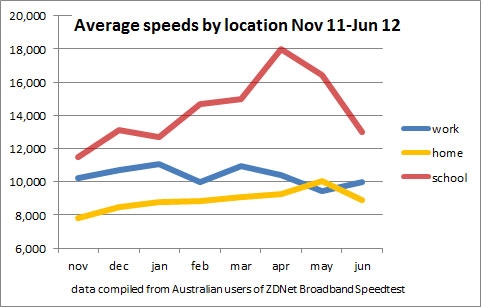Up to speed: Aussie home users catch up

The last half year has seen Australian home users upgrading their DSL speeds, signing up for emerging fibre offerings or taking advantage of reductions in the price of cable connections. That's seen the average speed of a home connection, as measured by the ZDNet Broadband Speedtest, increase from around 8Mbps to 10Mbps — a sharp rise over a matter of months. Work connections, meanwhile, have held steady around the 10Mbps mark, with no significant improvement.

(Credit: Phil Dobbie/ZDNet Australia)
It should be noted that these results are not an exact science. They are based on users of the ZDNet Broadband Speedtest, which is likely to have a bias towards users with concerns over the speeds they're getting. It's likely, therefore, that we're missing those major corporate users with big, fat pipes into their premises — users for whom speed is never a concern. In fact, of the 7700 speedtests taken at work in June, more than half are on DSL. Average work speeds are also being held down by wireless user results (3G and 4G), which accounted for 11 per cent of all at-work tests, and only 8 per cent of those at home.
Still, the biggest reason for the closing gap is because average home speeds are increasing, thanks to faster DSL speeds and a higher proportion of home users on fibre (from 1.6 per cent of users in April to 2 per cent in June).
Speeds at schools are generally noticeably faster than those for home or work users. Though there was recently a sudden drop in average school speeds (which we'll examine in a future article), those at school are enjoying the best speeds (even though one third of them rely on DSL connections). This comes from the fact that school DSL speed results are markedly higher than the other categories. In June, tests on school DSL connections averaged 10.8Mbps, compared to 6.5Mbps for those at work, and 5.6Mbps for home users.
A significant influence on these results could be the distance-decay effect experienced with copper. Schools are, perhaps, more likely to be centrally located, closer to phone exchanges. Businesses are spread slightly further, and homes, of course, have the greatest geographic spread.
If this is the reason for variance in DSL speeds, it's a clear demonstration of the need for fibre to the premises, or, at the very least, fibre to the node.